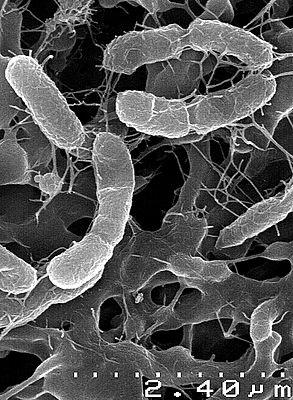Venivibrio stagnispumantis
| Venivibrio stagnispumantis | ||||||||||||
|---|---|---|---|---|---|---|---|---|---|---|---|---|

Electron microscope image of venous vibrio stagnispumantis cells |
||||||||||||
| Systematics | ||||||||||||
|
||||||||||||
| Scientific name of the genus | ||||||||||||
| Vein ivibrio | ||||||||||||
| Hetzer et al. 2008 | ||||||||||||
| Scientific name of the species | ||||||||||||
| Venivibrio stagnispumantis | ||||||||||||
| Hetzer et al. 2008 |
Venenivibrio stagnispumantis is a thermophilic , hydrogen- oxidizing bacterium and the only representative of the genus Venenivibrio .
morphology
The slightly curved rods are 1.04 to 1.56 µm long and 0.33 to 0.41 µm wide.
Occurrence
The strain CP.B2 was isolated and characterized from the thermal spring “ Champagne Pool ” (75 ° C, pH 5.5) in the geothermal area Wai-O-Tapu ( New Zealand ) and was first described in 2008 by Adrian Hetzer, IR McDonald and HW Morgan.
With a diameter of 65 m, a depth of 62 m and an estimated water volume of 50,000 m³, " Champagne Pool " is one of the largest geothermal springs in New Zealand. The approx. 75 ° C hot water is oversaturated with the metalloid compounds orpiment (As 2 S 3 ) and stibnite (Sb 2 S 3 ), which precipitate and form an orange sediment (see figure). The name “Champagne Pool” is derived from the continuous stream of gas bubbles that rise to the surface of the water, comparable to gas pearls in a flute of champagne. The gas mixture that escapes consists mainly of carbon dioxide (CO 2 ), with a small proportion of nitrogen (N 2 ), methane (CH 4 ), hydrogen (H 2 ), hydrogen sulfide (H 2 S) and traces of oxygen (O 2 ). Theoretically, H 2 in combination with CO 2 or O 2 would be conceivable as possible energy sources for the autotrophic growth of methanogenic or hydrogen-oxidizing microorganisms.
Growing conditions
Venenivibrio stagnispumantis is obligate chemolithotrophic , i.e. That is, energy for metabolic processes is obtained from chemical reactions with inorganic compounds. The bacterium uses H 2 as an electron donor , O 2 as the corresponding electron acceptor and CO 2 as a carbon source. Energy for metabolism is obtained through the so-called oxyhydrogen reaction H 2 + ½ O 2 → H 2 O. Elemental sulfur (S 0 ) or thiosulfate (S 2 O 3 2− ) are necessary for growth. Cell growth took place under thermophilic conditions between 45 ° C and 75 ° C (optimum 70 ° C), under moderately acidophilic conditions between pH 4.8 and 5.8 (optimum pH 5.4) and under microaerophilic conditions between 1.0 and 10 , 0% ( v / v ) O 2 (optima between 4.0 and 8.0% (v / v) O 2 ) instead.
Tolerance to arsenic and antimony compounds
Venenivibrio stagnispumantis tolerates relatively high concentrations of arsenic and antimony compounds . Cells grow in the presence of 8 mM arsenite (As 3+ ), 15 mM trivalent antimony (Sb 3+ ) and> 20 mM arsenate (As 5+ ). Cell growth could not be detected when As 3+ and As 5+ were provided as the only electron donor and acceptor pair.
Systematics
Venenivibrio [ veˌneːniˈvi.bri.oː ] (Latin: "the vibrion of poison"; with reference to the cell shape and the relatively high concentrations of metal oxide compounds in the habitat ) stagnispumantis [ stag.niːspuːˈman.tɪs ] (Latin: "from bubbling water "; With reference to" Champagne Pool ").
Venenivibrio stagnispumantis strain CP.B2 is deposited in the "Japan Collection of Microorganisms" under JCM 14244, in the German Collection of Microorganisms under DSM 18763 and in the "American Type Culture Collection" under ATCC BAA-1398.
The phylogenetic analysis of the 16S rRNA gene revealed that strain CP.B2 belongs to the order Aquificales and represents the type strain of a new species and genus within the family Hydrogenothermaceae . The 16S rRNA gene sequence for strain CP.B2 is stored in the GenBank nucleotide sequence database under DQ989208. The guanosine-cytidine content of the genomic DNA is 29.3 mol%, the lowest value ever determined for a species of the order Aquificales .
Individual evidence
- ↑ a b c d e f g A. Hetzer, IR McDonald, HW Morgan: Venenivibrio stagnispumantis gen. Nov., Sp. nov., a thermophilic hydrogen-oxidizing bacterium isolated from Champagne Pool, Waiotapu, New Zealand . In: International Journal of Systematic and Evolutionary Microbiology , 2008, 58, pp. 398-403, PMID 18218938 .
- ^ A. Hetzer, HW Morgan, IR McDonald, CJ Daughney: Microbial life in Champagne Pool, a geothermal spring in Waiotapu, New Zealand . In: Extremophiles , 2007, 11, pp. 605-614, PMID 17426919 .
- Jump up ↑ JG Pope, KL Brown, DM McConchie: Gold concentrations in springs at Waiotapu, New Zealand: Implications for precious metal deposition in geothermal systems . In: Economic Geology , 2005, 100, pp. 677-687.
- ↑ B. Jones, RW Renaut, MR Rosen: Biogenicity of gold- and silver-bearing siliceous sinters forming in hot (75 degrees C) anaerobic spring-waters of Champagne Pool, Waiotapu, North Island, New Zealand . In: Journal of the Geological Society , 2001, 158, pp. 895-911.
